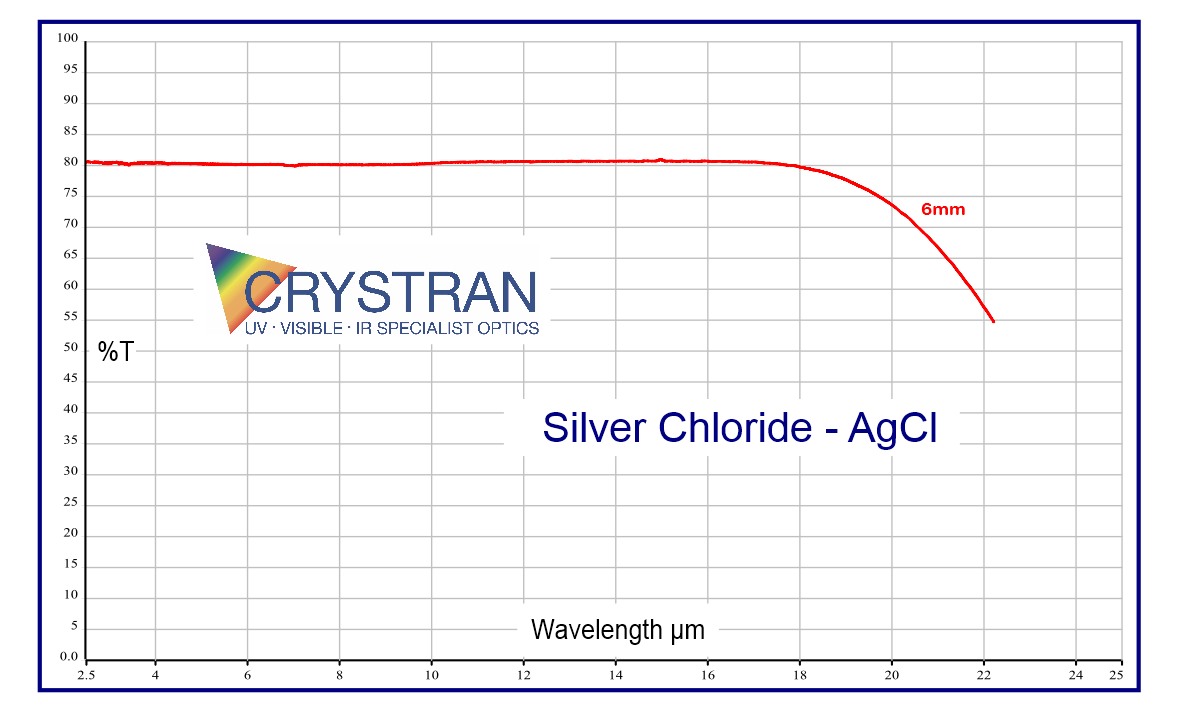

Silver Chloride AgCl
Silver Chloride is a useful material for deep IR applications where sensitivity to moisture is a problem. This soft crystal deforms under heat and pressure and can be forged in polished dies to create IR windows and lenses. A major use for Silver Chloride is in the manufacture of small disposable cell windows for spectroscopy, known as mini-cells. These windows have a depression of controlled thickness pressed into the surface. The inherent cost of Silver Chloride material is offset against ease of manufacture.


| µm | No |
|---|---|
| 0.5 | 2.09658 |
| 1.0 | 2.02239 |
| 1.5 | 2.01047 |
| 2.0 | 2.00615 |
| 2.5 | 2.00386 |
| 3.0 | 2.0023 |
| 3.5 | 2.00102 |
| 4.0 | 1.99983 |
| 4.5 | 1.99866 |
| 5.0 | 1.99745 |
| 5.5 | 1.99618 |
| 6.0 | 1.99483 |
| 6.5 | 1.99339 |
| 7.0 | 1.99185 |
| µm | No |
|---|---|
| 7.5 | 1.99021 |
| 8.0 | 1.98864 |
| 8.5 | 1.98661 |
| 9.0 | 1.98464 |
| 9.5 | 1.98255 |
| 10.0 | 1.98034 |
| 10.5 | 1.97801 |
| 11.0 | 1.97556 |
| 12.0 | 1.97026 |
| 12.5 | 1.96742 |
| 13.0 | 1.96444 |
| 13.5 | 1.96133 |
| 14.0 | 1.95807 |
| 14.5 | 1.95467 |
| µm | No |
|---|---|
| 15.0 | 1.95113 |
| 15.5 | 1.94743 |
| 16.0 | 1.94358 |
| 16.5 | 1.93958 |
| 17.0 | 1.99354 |
| 17.5 | 1.93109 |
| 18.0 | 1.9266 |
| 18.5 | 1.92194 |
| 19.0 | 1.91710 |
| 19.5 | 1.91208 |
| 20.0 | 1.90688 |
| 20.5 | 1.90149 |
Silver Chloride is grown into small ingots by the sealed-ampoule Stockbarger techniques. Silver chloride is malleable and milky-white it darkens in sunlight, but mild darkening does not affect the IR performance.
REFERENCES:
(1) Handbook of Optical Constants, ed Palik, V3, ISBN 0-12-544423-0